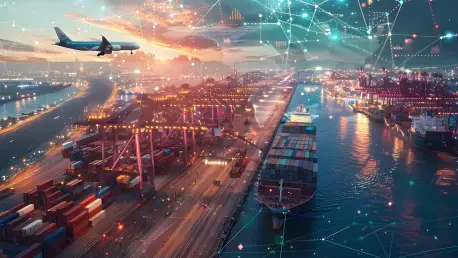Overview of Mexico’s Cargo Transport Landscape
Mexico’s cargo transport sector stands at a critical crossroads, grappling with inefficiencies that threaten its global competitiveness, as trucks continue to dominate with 57% of domestic freight moved by road according to recent data from CANACAR. This heavy reliance on highways creates bottlenecks, elevates costs, and strains infrastructure, highlighting an urgent need for alternative solutions in a nation pivotal to North American trade. The logistics industry, a backbone of economic growth, faces mounting pressure to evolve amid rising demand and environmental concerns.
Beyond road transport, rail and maritime sectors play supporting roles, with rail handling 13.25% of cargo as reported by industry sources, while key players like Ferrovalle and BNSF Railway drive operational advancements. Maritime routes complement these efforts, particularly for international shipments, yet their integration remains limited. Technology, including GPS tracking and digital platforms, has begun to enhance efficiency and transparency, though adoption varies across segments.
The economic weight of logistics cannot be overstated, as it underpins Mexico’s role as a manufacturing hub and trade partner in the USMCA framework. Delays or inefficiencies ripple through supply chains, impacting costs for businesses and consumers alike. Addressing these challenges is not just a matter of operational improvement but a strategic imperative for maintaining Mexico’s standing in global markets.
The Case for Intermodality in Freight Logistics
Key Trends and Benefits Driving Adoption
Intermodal transport, combining rail for long-distance hauls with trucks for shorter, localized deliveries, emerges as a compelling answer to Mexico’s freight woes. This approach reduces handling times and offers substantial cost savings, with studies suggesting reductions of up to 70% on certain corridors. Moreover, it aligns with sustainability goals, as rail consumes significantly less fuel per ton-kilometer compared to trucks, according to data from SENER.
Environmentally, the shift to intermodality promises a marked reduction in emissions, while operationally, a single train can replace up to 240 trucks, easing highway congestion. Security also improves, with theft rates on key intermodal routes as low as 0.5%, a stark contrast to vulnerabilities faced by road-only shipments. These advantages position intermodality as a practical solution for both cost-conscious businesses and eco-aware policymakers.
Emerging trends such as nearshoring, where companies relocate closer to North American markets, further fuel interest in intermodal systems. Cross-border freight, a growing segment, benefits from seamless modal integration, reducing transit times and enhancing reliability. As demand for efficient logistics grows, intermodality stands out as a scalable model to meet modern supply chain needs.
Market Insights and Growth Potential
Despite its promise, intermodal transport currently holds a modest 5% share of Mexico’s logistics market, according to AMTI, with rail contributing a larger but still limited portion. This low penetration reflects untapped potential, especially as challenges like a projected truck driver shortage—expected to nearly double over the next few years—loom large. Such gaps underscore the urgency of diversifying transport modes.
Cross-border rail volumes offer a glimpse of growth, with hundreds of thousands of cars moved annually between Mexico and the United States, as per the Association of American Railroads. This figure, with a significant intermodal component, highlights the system’s capacity to handle complex trade flows. Projections suggest continued increases, driven by trade agreements and manufacturing shifts.
Looking ahead, intermodality could redefine Mexico’s freight landscape by addressing systemic inefficiencies and bolstering its role in North American supply chains. Investments in rail infrastructure and modal integration are critical to realizing this vision. If harnessed effectively, this approach may not only alleviate current pressures but also position Mexico as a logistics leader in the region.
Challenges Hindering Intermodal Adoption
Structural barriers pose significant obstacles to the wider embrace of intermodal transport in Mexico. A primary issue lies in the lack of client awareness about processes like inland customs clearance and the operational scope of regional terminals, which often serve areas within a 200-300 km radius. Many shippers remain unfamiliar with the planning required, limiting adoption.
Operational complexities further complicate the transition, as intermodality demands meticulous coordination and infrastructure adjustments on the client side. Unlike trucking, which offers perceived speed and simplicity, intermodal shipments often face mismatched expectations regarding transit times. This gap in understanding can deter businesses accustomed to traditional road-based logistics.
Potential solutions include targeted education campaigns to familiarize stakeholders with intermodal benefits and requirements. Additionally, investments in scalable infrastructure, such as expanded rail terminals and streamlined customs facilities, could ease coordination among rail operators, truckers, and clients. Overcoming these hurdles requires a concerted effort to bridge knowledge and operational divides.
Regulatory and Security Framework for Intermodal Transport
The regulatory environment governing cargo transport in Mexico encompasses a range of customs processes and compliance mandates, particularly for cross-border freight under international trade agreements. These rules, while essential for ensuring smooth operations, often add layers of complexity that intermodal systems must navigate. Streamlining such procedures remains a priority for enhancing efficiency.
Security stands as a notable advantage of intermodality, with lower theft risks compared to road-only transport, providing reassurance to cargo owners. Private railway investments also play a vital role by reducing the strain on public highway funding, allowing resources to be allocated elsewhere. This synergy between private and public efforts strengthens the logistics framework.
Public projects, such as the Interoceanic Corridor of the Isthmus of Tehuantepec (CIIT), demonstrate alignment with regulatory goals to boost logistics capacity. By facilitating multi-modal connectivity, these initiatives aim to cut transit times and costs while adhering to compliance standards. Such developments signal a commitment to modernizing Mexico’s transport ecosystem through structured policy support.
Future Outlook for Intermodality in Mexico
Intermodal transport holds the potential to fundamentally reshape Mexico’s freight system, propelled by innovations like real-time tracking services exemplified by initiatives such as Quantum de México. These advancements promise greater visibility and reliability, addressing longstanding concerns about shipment delays. As technology evolves, it could further optimize modal integration.
Nearshoring trends, alongside public infrastructure projects like the Mayan Train freight terminals, are poised to accelerate intermodal growth. These developments cater to rising demand from manufacturers seeking proximity to North American consumers, reinforcing Mexico’s strategic position. The interplay of private innovation and government support creates a fertile ground for expansion.
External factors, including global economic shifts and environmental imperatives, will also shape the trajectory of intermodality. Pressures to reduce carbon footprints may drive further shifts toward rail-based solutions, while economic fluctuations could influence investment priorities. Sustained collaboration among stakeholders remains essential to navigate these dynamics and maintain momentum in transforming freight logistics.
Conclusion and Recommendations for Progress
Reflecting on the comprehensive analysis, it is evident that intermodal transport offers a transformative pathway to tackle Mexico’s cargo transport challenges, balancing economic gains with environmental and operational improvements. The journey, however, reveals persistent barriers that demand strategic intervention to unlock full potential.
Looking ahead, actionable steps emerge as critical for progress, including robust education programs to equip shippers with the knowledge to embrace intermodal processes. Investments in digital tools for tracking and coordination, alongside physical infrastructure like expanded rail networks, stand out as priorities to enhance system efficiency.
Moreover, fostering stronger alignment among rail operators, road carriers, customs authorities, and clients proves vital to minimize delays and costs. These efforts, if pursued with dedication, promise to establish intermodality as a cornerstone of Mexico’s logistics future, paving the way for heightened competitiveness on the global stage.









